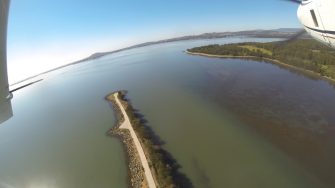
Date: Tuesday, October 22, 2019
Project: Eastern Australian Waterbird Survey
Observers: Richard Kingsford & Paul Wainright
Pilot: Tim Dugan
This week’s leg of the survey heads south, surveying the eastern edges of Bands 3 (just south of Sydney), Band 2 on the south coast of NSW and Band 1, which is at a latitude south of Melbourne. Avon and Cordeaux Dams were first on a list, part of Sydney’s water supply. Both dams were at low levels.
Cordeaux Dam was as the lowest water levels I have seen. When it gets this shallow, the waterbirds start coming in because it is shallow and there are feeding areas and so for the first time we saw a few pelicans, swans, little grebes and some teal. And up to a dozen deer.
Then down to the coast for a circuit of Lake Illawarra, near Wollongong, where there were about a couple of hundred swans and a few cormorants. Nothing unremarkable here compared to previous years. I would have expected to see more birds on these coastal lakes, given the state of the rivers and wetlands west of the Great Dividing Range.
After a brief stop off to refuel at Moruya, we finished the coastal lakes and inlets on the eastern side of Band 2 around Bermagui. There were very few ducks and the usual few hundred black swans and cormorants.
Then across the Monaro plain, near Cooma, which can be excellent waterbird habitat, when all its little lagoons fill but today there was just the odd farm dam with water. These are not nearly as good as the natural shallow wetlands that dot the Monaro Plain. It was very dry. Some of the creek lines had a tinge of green in a very brown land and so there must have been some recent rain.
Jindabyne Dam only had silver gulls with no suitable habitat for ducks, despite the large area of water. It is very unproductive.
This was where we finished the eastern end of Band 2 and so headed south for the most southernmost survey band, band 1, which runs east to west from Seaspray, south of Melbourne to Port Fairy in the east. The coastal lakes around Seaspray on the east coast of Victoria were pretty wet last year but were mostly dry this year. Wetlands like Jack Smith Lake can be great waterfowl habitat but not in 2019.
Down here in Victoria was so different to what we have seen elsewhere, over the last three weeks to the north, during our surveys. We could have been in a different country, with the wonderful green carpet of pastures and full dams everywhere. There were some of these dams with black duck and grey teal. On across Phillip Island where there was a colony of a few hundred straw-necked ibis and Australian white ibis nesting, near the town of Rhyll. This was so different to other parts of the survey. Waterbirds seem to be doing well in this the most southern part of the mainland.
We have also started to see the odd brood of black swans, which I hadn’t expected but then I hadn’t realised how much rain has fallen down here (above average according to our Warrnambool taxi driver). There seemed to be more Cape Barren Geese down here on Phillip Island than we have seen before, up to a few hundred. We then surveyed a few large dams in the Otways which had a few waterbirds, usually there are none, and then on to the dams south of Colac. Here there were small flocks of three to four ducks, not as many as I would have expected given the dry to the north. The small lagoons east of Warrnambool had their usual good numbers of Australian shelduck and a few teal. One lagoon east of the town even had a few magpie geese.
